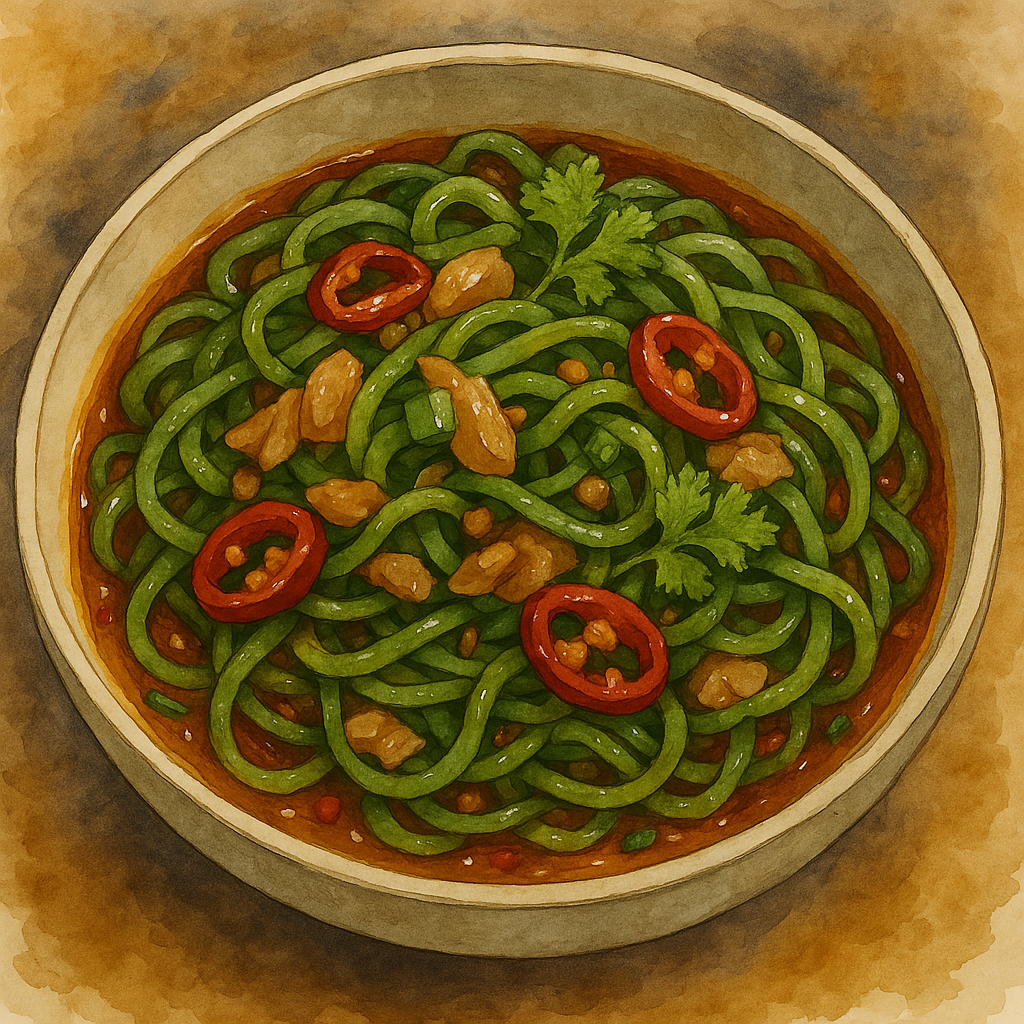Xiāngchéng
Appledance’s Guide to Culinary Excellence Entry VIII · Spicehaven: Where Every Breeze Whispers Warm Climes
By Delilah Appledance, Eth Dreythna’s Wandering Hearthkeeper
La-la-la… Imagine stepping off the Jade River barge into Xiāngchéng’s bustling dock, where lanterns swing above stalls heaped with ruby-red dried chilli blossoms, twisted black starleaf pepper vines, and jars of golden cardvine dust. Locals call it Spicehaven for the heady perfume that drifts on every wind, an ever-changing tapestry of ginger-bright mornings and cinnamon-warm twilights.
Founded five centuries ago by human traders seeking a shortcut from the southern tropics, Xiāngchéng sprouted where the Jade River delta meets the Sea of Jade’s calm estuary. Its climate is a balmy monsoon dance—torrential summers that coax turmeric root from the riverbank clay, and gentle winters mild enough to ripen cinnamon bark and red Sichuan vines on terraced hillsides. Over time, merchants from orc clans, halfling caravans, and elven spice-runners made their homes here, weaving a tapestry of tongues and flavours that even Eth Dreythna’s wandering hearth envies.
Trade and industry centre on Spicehaven’s great grinding mills, ancient stone wheels turned by waterwheels powered by the Jade’s swift current. Convoys depart for Vush’s inland markets every dawn, laden with jars of pickled ginger pearls and sacks of lotus-scented herb blends. At the world-famous Grand Spice Auction, buyers bid on rare imports: emerald-seed pepper pods from equatorial isles and smoked cinnamon peels from desert caravans. The city’s wealth rests on these scents, yet local growers guard their secret strains like cherished family recipes.
Tourists flock here for more than commerce. They drift through floating night-markets draped in silken banners, sample old lady Tang’s Palm Sugar Tea beside open-air shrines to The Monsoon Queen, or gamble at spice-wheel gambling houses where a single spin names your fortune in saffron threads. Similar to our own Amberleaf Harvest Festival, the mid-autumn Lantern of Fragrance festival sees hundreds of scented lanterns adrift onto the Jade’s glassy surface, an event so renowned that even Eth Dreythna’s traders send representatives to collect lantern ashes for use in aromatic cakes.
I had the pleasure of getting to work with some of the local ingredients during my travels around as an apprentice chef, which is where I created my spiced jade noodles. I was inspired by the city’s lively hawker stalls, and wanted to bring a taste of Spicehaven back to Eth Dreythna. One bite carries the monsoon’s heat, the delta’s sweetness, and the mingled souls of a thousand spice-runners. Tra-la…
~ Mrs. A
Government
Xiāngchéng is governed by a Council of Merchants, a body representing the city’s foremost spice traders, river barge captains, and guild elders. This merchant oligarchy operates under the nominal authority of a Commissioner, appointed by the court of the Queen of Grain and Floods and charged with ensuring loyalty to the Empress. Temple priests of the Queen hold an advisory seat on the council, their sacred rites and harvest prophecies informing major policy decisions. Together, these institutions balance private commercial interests with the city’s spiritual obligations, creating a pragmatic yet ritual-infused system of civic administration.
Defences
Guarding Xiāngchéng’s prosperity are stout limestone ramparts lining the river approaches, reinforced at chokepoints by granite bastions and watchtowers. A permanent river fleet of sail-rigged junks patrols the waterways, their decks armed with ballistae to ward off corsair raiders. The city militia, drawn from resident halfling, elven, and orc clans bound by vows to the Queen, mans the ramparts and fields rapid-response units for riverbank patrols. In times of civil unrest or external threat, merchant-financed gunpowder reserves and bulked stores of preserved spices serve both as deterrent and asset, ensuring Xiāngchéng can weather sieges without crippling food shortages.
Infrastructure
The backbone of Xiāngchéng’s economy lies in its elaborate canal network, which channels the Jade River’s seasonal floods into terraced spice gardens and rice paddies on the city’s outskirts. Floodgates and weirs regulate water levels, protecting low-lying markets from monsoon surges while irrigating cinnamon groves and turmeric banks. Covered arcade markets and raised stone causeways allow commerce to continue unimpeded during high water, and dozens of arched stone bridges, each named for a local spice or herb, link residential quarters to trading districts.
Architecture
Xiāngchéng’s skyline is a harmonious fusion of red-clay brick and lacquered timber, crowned by the scalloped copper domes of the Temple of the Queen of Grain and Floods. Grand traders’ houses stand two stories tall, their broad eaves gracefully curving upward to shed monsoon rains, while spice warehouses perch on elevated stone pilings above the canals to guard against floodwaters. Market pavilions feature openwork lattice screens that admit cooling breezes, and residential alleys are shaded by rows of fragrant citrus trees. Throughout, decorative motifs of sheaves, waves, and spice pods, carved in wood and bronze, celebrate the city’s dual devotion to commerce and the Empress’s bounty.
Spiced Jade Noodles
- 1 pound fresh Jade River rice noodles
- 2 tablespoons toasted sesame oil
- 1 teaspoon ground starleaf pepper
- 1 tablespoon Sichuan vine flakes
- 2 cloves garlic, minced
- ½ cup pickled ginger pearls, drained
- 3 tablespoons chilli-bean paste (local equatorial blend)
- 2 scallions, thinly sliced
- 1 handful coriander sprigs




Comments